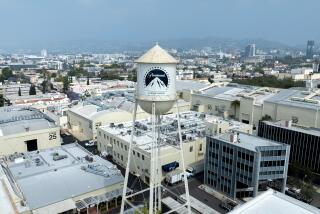Risky quest for treasure
The Indiana Jones series is known for its cliffhangers. But the real cliffhanger in the long-awaited upcoming sequel is when -- and perhaps even if -- the famous filmmakers and the star will make money.
That’s because before executive producer George Lucas, director Steven Spielberg and leading man Harrison Ford get their hands on any treasure, Paramount Pictures will need to collect $400 million in revenue to recover all its costs and make a sizable fee to distribute “Indiana Jones and the Kingdom of the Crystal Skull.”
If that seems like a no-brainer, consider the norm in Hollywood, where top-tier filmmakers and stars traditionally earn huge upfront fees and get a big cut of ticket sales before a studio recoups its investment.
The atypical arrangement between the studio and the triumvirate illustrates the new economic realities of the movie business. As production and marketing costs continue to escalate amid flat theater attendance and declining DVD sales, studios are increasingly looking for ways to protect themselves from colossal losses on a single picture.
“It’s good for both parties,” said media analyst Harold Vogel. “If the talent has a true belief in the movie, they are taking a little more risk by getting no significant compensation upfront but a much larger share of the ultimate profitability,” he explained. “It makes sense for studios, which are cash-constrained.”
With the economics of the movie industry becoming less lucrative in recent years, the studios would prefer to have talent shoulder more of the risk. One way is getting expensive stars, directors, writers and producers to defer their customary fees and forfeit their cut of box office dollars from the first ticket sold, known as first dollar gross.
Walt Disney Studios, for example, had such an arrangement with producer Jerry Bruckheimer and star Johnny Depp on the “Pirates of the Caribbean” movies, and Bruckheimer and actor Nicolas Cage on the recent “National Treasure” sequel. On those hits, everyone made money.
However, most movies are not big hits, which is why studios like these so-called break-even deals. It also can prevent them from losing their shirts. Sony Pictures would have lost a lot more than it did on “The Holiday” had writer-director Nancy Meyers and stars Cameron Diaz and Jude Law not agreed to forgo their usual “first-dollar” paydays. Instead, they earned their upfront cash fees.
The 2006 romantic comedy, which cost more than $100 million to produce, grossed only $63 million at the U.S. box office and had weak DVD sales.
“Crystal Skull,” which opens worldwide May 22, is the first “Indiana Jones” movie in 19 years. The fourth installment in one of Hollywood’s iconic franchises arrives after years of development, script rewrites and dashed hopes among fans who are anxious to see how the archaeologist-adventurer outsmarts another gang of nefarious forces.
Most movie franchises, including “Harry Potter,” “Pirates of the Caribbean” and “Spider-Man,” are owned by studios. The “Indiana Jones” copyright, however, is held by Lucas, who created the adventure story in the 1970s. Lucas, who also invented the “Star Wars” empire, is one of the few contemporary filmmakers to own and control his movie properties.
The structure of the deal between Paramount and Lucas’ San Francisco-based Lucasfilm Ltd. predated the current 3-year-old regime at Paramount, headed by Brad Grey. Grey and his associates subsequently tweaked the arrangement to further lower the studio’s risk. When it became clear the movie would cost more than expected, Lucas, Spielberg and Ford agreed to offset it by waiving their large upfront fees.
Paramount executives declined to be interviewed, as did Spielberg, Lucas and Ford. However, several people familiar with the deal behind “Crystal Skull” spoke on condition of anonymity because of the confidential arrangement.
According to these people, Paramount spent about $185 million to make the movie and will pay at least $150 million to market it worldwide. The studio will earn a distribution fee of 12.5% of the revenue it receives from the film’s release in all media, including theaters, DVD and television.
In comparison, 20th Century Fox received a distribution fee of 6% to 8% for releasing Lucas’ “Star Wars” movies. Fox’s fee was smaller because Lucasfilm finances the “Star War” movies entirely and effectively pays the studio for distribution. Fox earned between $50 million and $75 million per picture, said a person familiar with the finances.
“Crystal Skull” will have to generate around $400 million for Paramount for the studio to make its money back and earn its distribution fee. Only at that point will Lucas, Spielberg, Ford and smaller profit participants, including screenwriter David Koepp, begin collecting their portion.
Paramount will take 12.5 cents from every dollar thereafter, while Lucas and company will earn 87.5 cents.
In the event that “Crystal Skull” fails at the box office, this arrangement will leave the filmmakers and talent empty-handed. Paramount would lose part of its investment, but not as much as it would have under a conventional deal with top talent.
Although the “Indiana Jones” franchise is considered one of Hollywood’s surest bets -- the first three pictures amassed $1.2 billion in worldwide ticket sales -- there is no guarantee that younger moviegoers will turn out in droves to see a now 65-year-old action hero in a fedora dust off his trademark leather jacket and crack his bullwhip. Today’s under-25 action junkies are wowed by computer-generated effects spectacles, such as “Spider-Man,” “Harry Potter,” “300” and “Fantastic Four.”
Set in 1957, the fourth Indiana Jones tale relies more on physical stunts than eye-popping effects as it chronicles Indy’s adventures battling Russians during the Cold War and racing through the Peruvian jungle in pursuit of the crystal skull. To appeal to the iPod-and-YouTube generation, Spielberg cast as Ford’s motorcycle-riding sidekick Shia LaBeouf, the 21-year-old star of last summer’s “Transformers.”
Though the deal struck between Paramount and the talent is designed to mitigate the studio’s financial risk -- and reward the filmmakers in success -- no one in Hollywood can predict the outcome.
“It’s still a very challenging business,” said Richard Greenfield, a media analyst with Pali Research. “The average movie still loses money.”
--
--
(BEGIN TEXT OF INFOBOX)
$335 million
Estimated cost of production and worldwide marketing for “Indiana Jones and the Kingdom of the Crystal Skull”
$400 million
Estimated net revenue to Paramount before filmmakers George Lucas and Steven Spielberg and star Harrison Ford get paid
$1.2 billion
Worldwide ticket sales for the three previous films in the franchise
Sources: Times research, Boxofficemojo.com
More to Read
The biggest entertainment stories
Get our big stories about Hollywood, film, television, music, arts, culture and more right in your inbox as soon as they publish.
You may occasionally receive promotional content from the Los Angeles Times.










